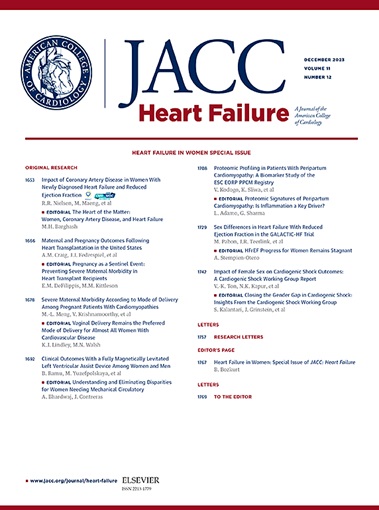Elevated Neutrophil-to-Lymphocyte Ratio Predicts Prognosis in Acute Myocarditis
IF 10.3
1区 医学
Q1 CARDIAC & CARDIOVASCULAR SYSTEMS
引用次数: 0
Abstract
Background
Neutrophil-to-lymphocyte ratio (NLR) is an easy-to-use inflammatory biomarker. Baseline NLR is independently associated with incident cardiovascular events and all-cause mortality. However, whether this applies to acute myocarditis (AM) has not been evaluated.
Objectives
The present study aimed to investigate the prognostic value of NLR in patients with AM.
Methods
A total of 1,150 consecutive patients with a diagnosis of AM admitted to 10 international tertiary referral cardiac centers were included in the study. The diagnosis was confirmed using cardiac magnetic resonance or endomyocardial biopsy. The primary outcome measure was a composite of all-cause mortality or heart transplantation. Patients were divided into 2 groups according to an NLR cutoff of 4 derived from spline regression analysis and 70:30 train-test split algorithm.
Results
Patients with an NLR <4 were younger and more likely to present with chest pain, and those with an NLR ≥4 were more likely to present with breathlessness and have other comorbidities. Over a median follow-up of 228 weeks, a NLR ≥4 was associated with a worse prognosis (P < 0.0001). After adjustment for prognostic variables, NLR emerged as an independent predictor of outcome (HR: 3.03 [95% CI: 1.30-7.04]; P = 0.010). Elevated NLR remained associated with worse outcomes among patients with preserved ejection fraction at baseline, who are conventionally considered to be at lower risk of adverse events (P < 0.0001).
Conclusions
In patients with AM, elevated NLR is associated with worse prognosis and may be valuable for stratifying patients, even those conventionally considered at low risk.
中性粒细胞与淋巴细胞比值升高预测急性心肌炎的预后。
背景:中性粒细胞与淋巴细胞比率(NLR)是一种易于使用的炎症生物标志物。基线NLR与心血管事件和全因死亡率独立相关。然而,这是否适用于急性心肌炎(AM)尚未评估。目的:本研究旨在探讨NLR对AM患者预后的价值。方法:共有1150名连续诊断为AM的患者被纳入10个国际三级转诊心脏中心的研究。诊断经心脏磁共振或心内膜心肌活检证实。主要结局指标是全因死亡率或心脏移植的综合指标。根据样条回归分析得出的NLR截断值为4,采用70:30训练-检验分割算法将患者分为两组。结论:在AM患者中,NLR升高与预后较差相关,可能对患者分层有价值,即使是那些传统上被认为是低风险的患者。
本文章由计算机程序翻译,如有差异,请以英文原文为准。
求助全文
约1分钟内获得全文
求助全文
来源期刊

JACC. Heart failure
CARDIAC & CARDIOVASCULAR SYSTEMS-
CiteScore
21.20
自引率
2.30%
发文量
164
期刊介绍:
JACC: Heart Failure publishes crucial findings on the pathophysiology, diagnosis, treatment, and care of heart failure patients. The goal is to enhance understanding through timely scientific communication on disease, clinical trials, outcomes, and therapeutic advances. The Journal fosters interdisciplinary connections with neuroscience, pulmonary medicine, nephrology, electrophysiology, and surgery related to heart failure. It also covers articles on pharmacogenetics, biomarkers, and metabolomics.
 求助内容:
求助内容: 应助结果提醒方式:
应助结果提醒方式:


